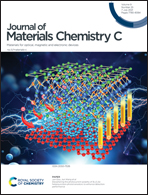Deciphering the photocurrent polarity of Bi2O2Se heterojunction phototransistors to enhance detection performance†
Abstract
With the emergence of bismuth-based oxychalcogenide materials, Bi2O2Se shows superiority in photodetection owing to its favorable mobility and air stability. Nevertheless, the photodetection performance is limited by its low bandgap and extinction coefficient in the near-infrared region. Here, by stacking C60/Bi2O2Se heterojunction onto graphene with a symmetrical electrode, we observed distinctive polarity variation in the broadband photocurrents (488–1550 nm) owing to the wavelength-dependent band alignment. Meanwhile, the all-negative polarity responses of graphene/Bi2O2Se demonstrate high photo-responsivity (∼7160 A W−1) with 1.7 × 106% external quantum efficiency, fast speed down to 57 μs and detectivity up to 6.96 × 1010 Jones, which are superior compared with previous work. A higher photo-responsivity (∼170 A W−1) communication band (1310 and 1550 nm) is realized for graphene/C60/Bi2O2Se than for previous related work. The coupling energy bands of Bi2O2Se and C60 were determined by first-principles calculation, suggesting two carrier transfer paths into the graphene channel (charge separation and tunneling injection). This was further verified by gate modulation and a control group. This unique photo-response phenomenon and high-performance phototransistor will enable next-generation large-scale array optical imaging and provide a valid platform for exploring communication band applications and polarity converting of photocurrents.

- This article is part of the themed collection: Journal of Materials Chemistry C HOT Papers


 Please wait while we load your content...
Please wait while we load your content...